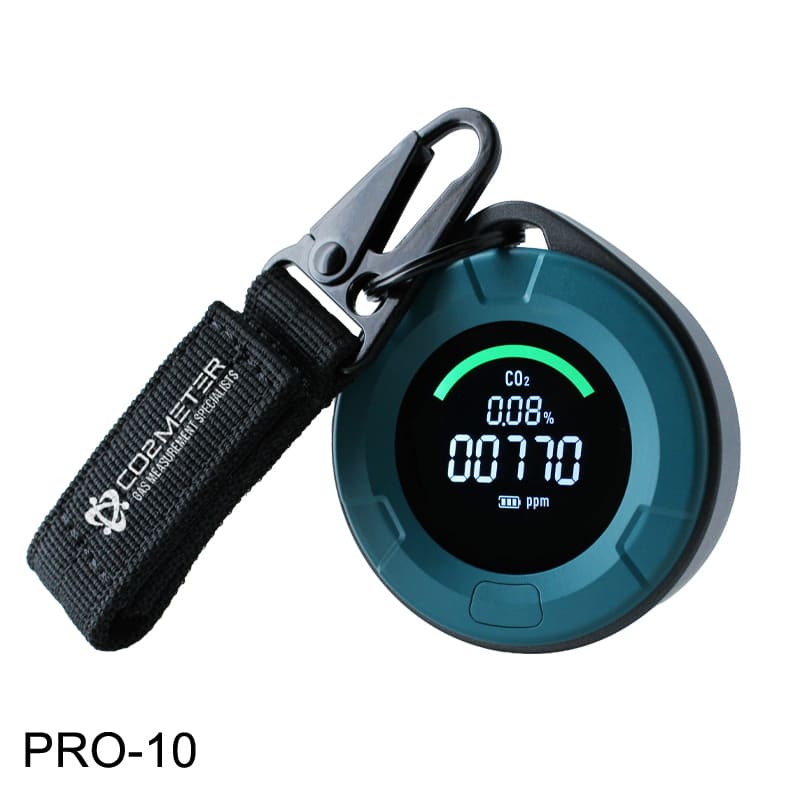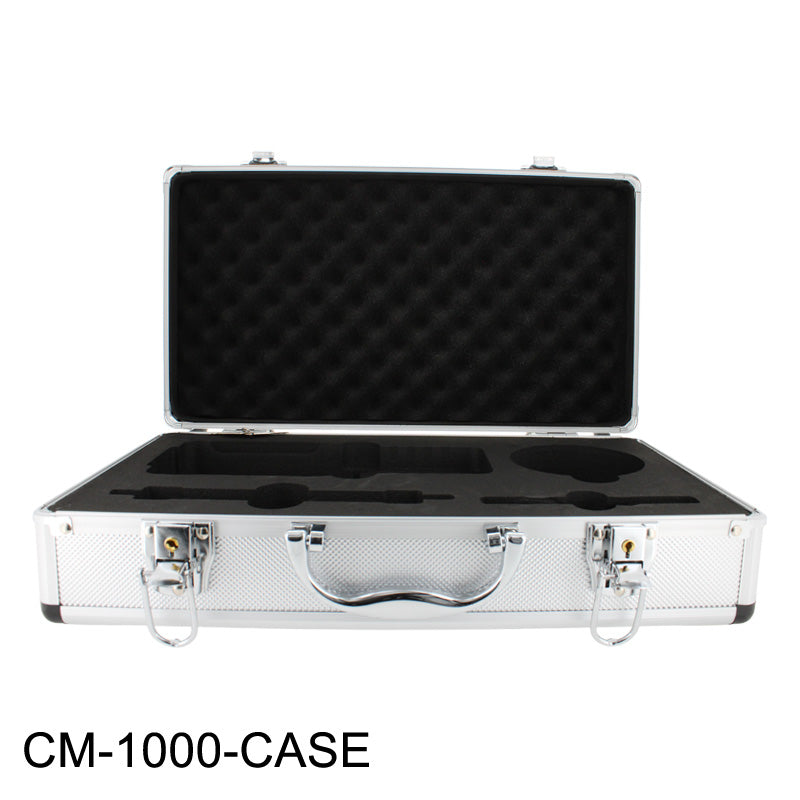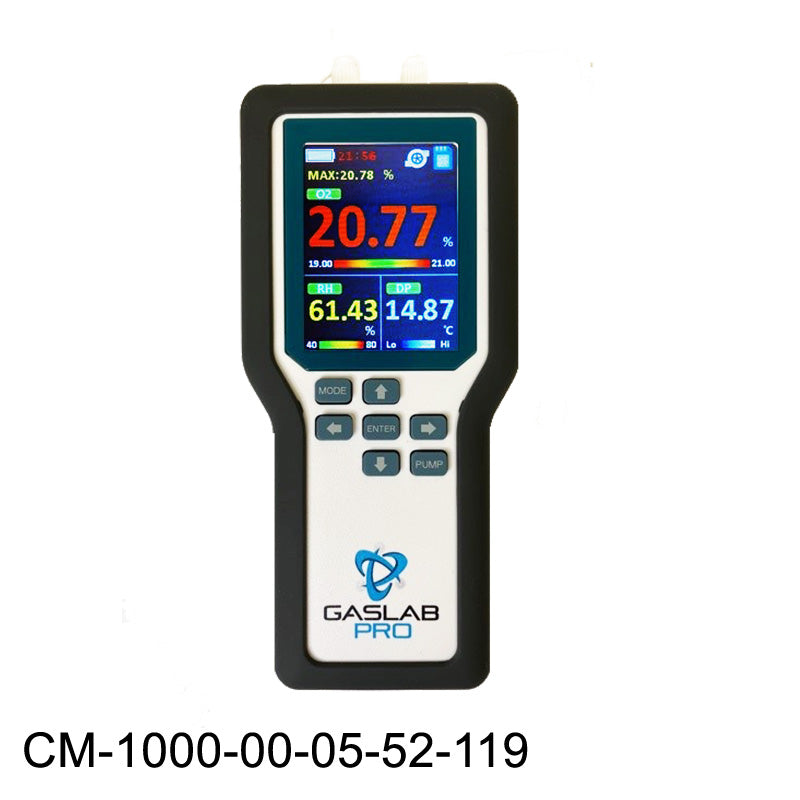Handheld Portable Gas Detectors
Stay safe anywhere with a portable gas detector or handheld gas monitor. These battery-powered devices provide fast, accurate detection of CO2, O2, or multiple gases in industrial, commercial, or confined space environments.
Choose between diffused air detectors for continuous monitoring or sampling gas detectors with built-in pumps for pinpoint leak detection. Portable CO2 meters and multi-gas detectors are ideal for breweries, laboratories, restaurants, medical facilities, agriculture, and HVAC safety checks.
Diffused Air - let you measure or monitor the air around you, indoors or outdoors. Because the internal battery only has to power the sensor, diffused air meters tend to use less power. However, they typically take about a minute to register changes in gas levels.
Air Sampling - contains a micro pump that pulls air into a port, sends it across the sensor inside, then expels it through a second port. The ports can be connected to the tubing so that the sampled gas is returned to a closed container. Since sampling meters react much more quickly to changes in gas levels a sampling meter can be used to check for leaks with pin-point accuracy.
Browse below to find the right portable gas detector, from affordable single-gas meters to professional multi-gas sampling analyzers with features like data logging and reporting.
-
Handheld
Portable 5% CO2 Safety Detector
The PRO-10: Portable 5% CO2 Safety Detector is designed for employees who work in enclosed areas where carbon dioxide buildup may...
5.0 / 5.0
(3) ( 3 )
$399.00 USD$399.00 USD$399.00 USD -
Select options
The GasLab® Pro 100% Carbon Dioxide Sampling Data Logger is designed to measure carbon dioxide (co2) concentrations in enclosed environments, used primarily...
$2,399.00 USD$2,399.00 USD$2,399.00 USD -
Handheld
Portable CO2 Detector and Alarm
The Portable CO2 Detector and Alarm is a handheld gas detector and data logger designed to measure concentrations in real-time with audible indication. Features...
4.33 / 5.0
(9) ( 9 )
$419.00 USD$419.00 USD$419.00 USD $349.00 USD -
The Carbon Monoxide (CO) Handheld Gas Detector is a portable data logger designed to measure carbon monoxide concentrations with long-term data...
$395.00 USD$395.00 USD$395.00 USD -
Select optionsHandheld
0-25% Oxygen O2 Sampling Data Logger
The 25% Oxygen Sampling Data Logger is designed to measure oxygen levels over time in enclosed environments, used primarily in life...
$2,399.00 USD$2,399.00 USD$2,399.00 USD -
The Carbon Dioxide and Carbon Monoxide Handheld Gas Detector is designed to measure both CO and CO2 concentrations in real-time with data...
5.0 / 5.0
(1) ( 1 )
$659.00 USD$659.00 USD$659.00 USD -
The CO2, CO, and O2 Portable Detector is designed to measure carbon dioxide, carbon monoxide, Oxygen, relative humidity and temperature across a variety...
5.0 / 5.0
(2) ( 2 )
$959.00 USD$959.00 USD$959.00 USD -
Handheld
CO2 and Ammonia Multi Gas Detector
The Carbon Dioxide and Ammonia Gas Detector is a multi-gas solutions designed for indoor agriculture applications like poultry farms who need to...
5.0 / 5.0
(1) ( 1 )
$779.00 USD$779.00 USD$779.00 USD -
Handheld
TecWeld Oxygen Analyzer
The TecWeld 0-2000ppm Oxygen Analyzer is designed to provide accurate gas measurements of oxygen content in welding and industrial applications. The...
$4,234.00 USD$4,234.00 USD$4,234.00 USD -
Handheld
TecPen MAP Oxygen Analyzer
The TecPen MAP Oxygen Analyzer is designed to provide accurate measurements of oxygen content in all closed and pierce-able food packaging,...
$4,234.00 USD$4,234.00 USD$4,234.00 USD -
The TecPen Oxygen and Carbon Dioxide Weld Purge Monitor is designed to provide accurate measurements down to 0% oxygen and up to...
$5,928.00 USD$5,928.00 USD$5,928.00 USD -
The Tecpen MAP Oxygen and Carbon Dioxide Analyzer ensures accurate oxygen and carbon dioxide gas level measurements in pierceable, shrink-wrapped packaging....
$5,928.00 USD$5,928.00 USD$5,928.00 USD -
Handheld
Dissolved Oxygen Meter
The TS-600 Dissolved Oxygen Meter provides customers with an accurate oxygen measurement in mg/L or parts per billion (ppb) in...
$4,840.00 USD$4,840.00 USD$4,840.00 USD -
Select options
The 20% Carbon Dioxide Sampling Data Logger is designed to measure carbon dioxide levels over time in enclosed environments, used primarily...
$2,399.00 USD$2,399.00 USD$2,399.00 USD -
Select options
The 25% Oxygen and 100% Carbon Dioxide Sampling Data Logger is is designed to simultaneously measure multiple gas concentrations through...
$2,700.00 USD$2,700.00 USD$2,700.00 USD -
Select options
The 25% Oxygen and 20% Carbon Dioxide Sampling Data Logger is is designed to simultaneously measure multiple gas concentrations through...
$2,250.00 USD$2,250.00 USD$2,250.00 USD -
Select options
The 1% Carbon Dioxide Sampling Data Logger is designed to measure carbon dioxide concentrations in enclosed environments such as indoor...
$2,399.00 USD$2,399.00 USD$2,399.00 USD -
Select options
The 25% Oxygen, 5000ppm CO and 1% Carbon Dioxide Sampling Data Logger is is designed to simultaneously measure multiple gas...
$3,000.00 USD$3,000.00 USD$3,000.00 USD -
Select optionsHandheld
Multi Gas Sampling Data Logger
The Multi Gas Sampling Data Logger is is designed to simultaneously measure multiple gas concentrations through a sampling method. Utilizing a...
5.0 / 5.0
(1) ( 1 )
$2,399.00 USD$2,399.00 USD$2,399.00 USD -
Handheld
Sampling Dissolved Oxygen Meter
The TS-700 Sampling Dissolved Oxygen Meter provides accurate oxygen measurements in mg/L or parts per billion (ppb) in water, beer,...
$5,999.00 USD$5,999.00 USD$5,999.00 USD
Don't Take Our Word for it, Take Theirs

Matthew Weintraub
Plant Manager
"Your solutions meet the code requirements and because of you our facility is much safer."

Angela Ihrig
Supply Chain Manager
"CO2Meter has helped protect 150+ of our customers sites and ensure they are compliant and safe."

Michael Hudkins, CFPS
Fire Plans Examiner/Fire Inspector II
"I would recommend CO2Meter gas training to anyone, it inspired us to be keenly aware of what to inspect."

Keith Isoldi
Chief Operating Officer
"I have always worked with CO2Meter because they are the industry leader."

Kelly Kissock
Faculty Director
"Easy to install, Our CO2 tank gassed off and the meter near it worked perfectly!"
Stay Informed with Our Latest Updates
Subscribe to our newsletter for the latest news, product updates, and industry insights.
CO2Meter is working with our global supply chain to minimize disruptions
Due to imposed tariffs, Quotes will be honored for 24 hours and may require a revised PO
CO2Meter is working with our global supply chain to minimize disruptions
Due to imposed tariffs, Quotes will be honored for 24 hours and may require a revised PO
CO2Meter is working with our global supply chain to minimize disruptions
Due to imposed tariffs, Quotes will be honored for 24 hours and may require a revised PO
CO2Meter is working with our global supply chain to minimize disruptions
Due to imposed tariffs, Quotes will be honored for 24 hours and may require a revised PO
CO2Meter is working with our global supply chain to minimize disruptions
Due to imposed tariffs, Quotes will be honored for 24 hours and may require a revised PO
CO2Meter is working with our global supply chain to minimize disruptions
Due to imposed tariffs, Quotes will be honored for 24 hours and may require a revised PO
CO2Meter is working with our global supply chain to minimize disruptions
Due to imposed tariffs, Quotes will be honored for 24 hours and may require a revised PO
CO2Meter is working with our global supply chain to minimize disruptions
Due to imposed tariffs, Quotes will be honored for 24 hours and may require a revised PO
CO2Meter is working with our global supply chain to minimize disruptions
Due to imposed tariffs, Quotes will be honored for 24 hours and may require a revised PO
CO2Meter is working with our global supply chain to minimize disruptions
Due to imposed tariffs, Quotes will be honored for 24 hours and may require a revised PO
CO2Meter is working with our global supply chain to minimize disruptions
Due to imposed tariffs, Quotes will be honored for 24 hours and may require a revised PO
CO2Meter is working with our global supply chain to minimize disruptions
Due to imposed tariffs, Quotes will be honored for 24 hours and may require a revised PO
CO2Meter is working with our global supply chain to minimize disruptions
Due to imposed tariffs, Quotes will be honored for 24 hours and may require a revised PO
CO2Meter is working with our global supply chain to minimize disruptions
Due to imposed tariffs, Quotes will be honored for 24 hours and may require a revised PO
CO2Meter is working with our global supply chain to minimize disruptions
Due to imposed tariffs, Quotes will be honored for 24 hours and may require a revised PO
CO2Meter is working with our global supply chain to minimize disruptions
Due to imposed tariffs, Quotes will be honored for 24 hours and may require a revised PO
CO2Meter is working with our global supply chain to minimize disruptions
Due to imposed tariffs, Quotes will be honored for 24 hours and may require a revised PO
CO2Meter is working with our global supply chain to minimize disruptions
Due to imposed tariffs, Quotes will be honored for 24 hours and may require a revised PO
CO2Meter is working with our global supply chain to minimize disruptions
Due to imposed tariffs, Quotes will be honored for 24 hours and may require a revised PO
CO2Meter is working with our global supply chain to minimize disruptions
Due to imposed tariffs, Quotes will be honored for 24 hours and may require a revised PO
CO2Meter is working with our global supply chain to minimize disruptions
Due to imposed tariffs, Quotes will be honored for 24 hours and may require a revised PO
CO2Meter is working with our global supply chain to minimize disruptions
Due to imposed tariffs, Quotes will be honored for 24 hours and may require a revised PO
CO2Meter is working with our global supply chain to minimize disruptions
Due to imposed tariffs, Quotes will be honored for 24 hours and may require a revised PO
CO2Meter is working with our global supply chain to minimize disruptions
Due to imposed tariffs, Quotes will be honored for 24 hours and may require a revised PO
CO2Meter is working with our global supply chain to minimize disruptions
Due to imposed tariffs, Quotes will be honored for 24 hours and may require a revised PO































